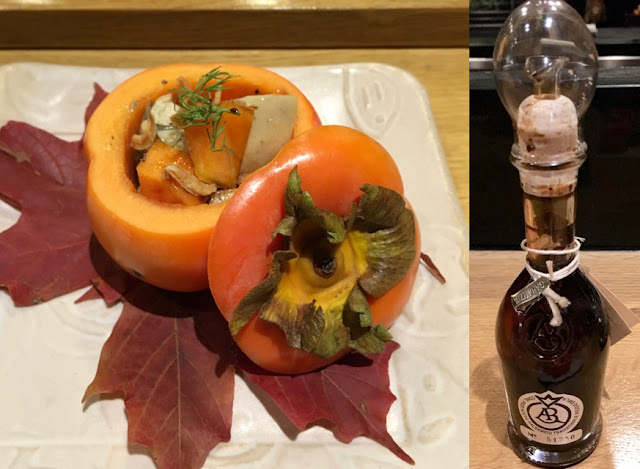Finally Michelin came to Washington, DC and bestowed a galaxy of stars upon the city. While no 3 star constellations appeared, once they were done, 2 stars appeared behind the name of three restaurants, and one star for eight others. Among the eight restaurants which received one star was our "special occasion" Japanese restaurant "Sushi Taro" すし太郎 in Dupont Circle. We didn't need Michelin to tell us how good Sushi Taro is. We had discovered that some time ago all on our own. We gave it top rating among all the excellent restaurants we have visited even in Japan. The "star" is well deserved and as far as we are concerned, it shines bright as Venus. Despite our concern that, with the additional fame of a star, we would have difficulty getting a reservation, we were able to get a seat recently and had a fabulously memorable dinner.
The night we were there, the main dining room was crowded and bustling but the Omakase Sushi Kaiseki 会席 area, which was separated from the main dining room, was serene and quiet. The roof top garden of bamboo highlighted in the large picture window in front of us contributed to the sense of tranquility. This was an Omakase (chef choice) dinner consisting of multiple small dishes reflecting the season and the best ingredients available. Sushi Taro deviates from a regular Kaiseki by prominently featuring sashimi and sushi. The counter accommodates 6 guests. They take only two parties and one seating per night. Each party gets the full undivided attention of Nobuhiro "Nobu" Yamazaki 山崎信博 (chef owner) or Masaya "Masa" Kitayama 北山勝也 (chef de cuisine) for the entire length of the dinner.
We were warmly greeted by Chef de cuisine Masaya Kitayama. After choosing our sake, "Kubota Manju Diaginjo" 久保田万寿大吟醸 from Niigata 新潟 and our Guinomi ぐい呑 sake cups, an incredible course of delicacies started. With the permission of Chef Masa, I took, or at least tried to take, some pictures. (Sometimes I got so wound up with excitement to taste the dish I forgot to take a picture.)
1. Grilled Goma-dofu 胡麻豆腐 with sesame sauce.
This is a variation of Sushi Taro's standard opening of "goma-dofu". The thin grilled crust contrasted with soft but elastic inside. Of course, freshly grated wasabi was nice with perfectly smooth sesame sauce.
2. House-smoked oyster with persimmon dressed in 150 year old balsamic vinegar 牡蠣と柿の和え物.
This was an autumnal dish using a persimmon as a bowl which contained bite size pieces of house-smoked oyster (Kaki 牡蠣 in Japanese) and persimmon (Kaki 柿 in Japanese). So this was a whimsical play on words "Kaki and kaki in kaki". Crispy bits of deep fried "onion" (I am guessing this was Tokyo scallion or "nihon negi" 日本ネギ) added nice flavor and crunch. The aged balsamic vinegar was sublime with just a hint of acidity and sweetness, which further brought out the sweetness of the persimmon. The oyster was lightly smoked and very tender. Every aspect of the dish worked well together.
3. Hassun 八寸 appetizer:
Okinawan mozuku seaweed in sweet vinegar 沖縄モズク, chestnut encased in edible imitation "Iga" outer spiky shell イガ栗揚げ, mustard stuffed-lotus root 辛子蓮根, stuffed ginko nuts 銀杏 (clockwise starting from left back) and pickled myoga ミョウガの甘酢漬け (center).
We were told that the chestnuts were from California. Among the batch of chestnuts Chef Masa received, he carefully chose those that did not have the tough inner shell separation characteristic of California chestnuts. The ones he used in this dish were visually perfect; just one example of his impeccable attention to detail. The chestnuts were cooked in a special way called "Shibukawa-ni" 渋皮煮. With this method, the papery brown inner skin is left on but is not bitter. The chestnut was encased in a puree of white fish ("surimi" すり身) and short segments of dried somen noodles ソーメン were attached to imitate "spines" of chestnut outer shell and deep fried. It was then partially opened up to show the chestnut inside, a nice depiction of chestnuts peeking through the outer spiny shell, but all edible. Each morsel in the dish provided a different taste and texture which were distinct and unique but went well together as a whole. For example, the stuffed lotus root had a nice crunch and a slight zing of mustard, which went well with the soft texture and vinegar of the seaweed which in turn played in tune with the somewhat sweeter vinegar but coarser texture of the myoga with its own unique flavor. All the items were perfect for sipping sake..
4. Simmered abalone 鮑の柔らか煮, Japanese "Komatsuna" greens 小松菜 and Japanese "sato-imo" taro 里芋 in oyster broth.
The broth was very special with an intense brininess and pleasing essence of "Ocean". It was made from the cooking liquid in which many oysters were simmered for another dish according to Chef Masaya. This concentrated oyster broth was the basis for the seasoning for this dish. Chef Masaya told us that abalone does not have much of its own flavor but has a nice texture. To boost the flavor of the abalone, he let the oyster and other umami flavors of the broth permeate the abalone. Although it is generally not polite to drink the broth in this kind of dish, it was way too good to leave behind; without shame we both drank it dry.
Next is the sashimi and sushi course (to be continued).





No comments:
Post a Comment